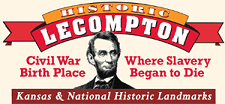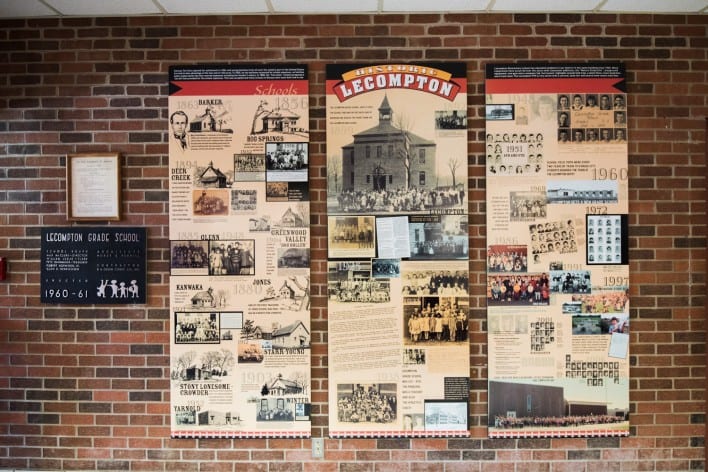- Lecompton was originally named Bald Eagle.
- Constitution Hall was built in 1856. It is quite possibly the oldest wooden building in Kansas.
- In the seven years that Kansas was a territory, six men served as territorial governor. Four others were acting-governor.
- Albert G. Boone, grandson of the famous frontiersman Daniel Boone, was one of the founders of Lecompton. Boone Street in Lecompton is named for him.
- Lecompton was named to honor the chief justice of the territorial supreme court, Samuel D. Lecompte, from Maryland
- The first ferry across the Kaw River at Lecompton was known as the Fairy Queen. The ferry was a simple, 20-foot, hollowed-out log owned by Thomas and William Simmons.
- The first dwelling in Lecompton was a log cabin owned by Thomas and William Simmons. A stone addition with a basement was added later. The cabin is gone, but the stone addition remains and today it is the Democratic Headquarters at the Bald Eagle River View Park.
- Lecompton was founded in 1854 on a 640-acre Wyandotte Indian land claim.
- The first permanent bridge at Lecompton was a challenging, 1000 foot long, five-span steel, one lane wood deck structure completed in 1899.
- Seven hotels operated in territorial Lecompton.
- Lane University was named for General and Senator James H. Lane.
- There were seven capital locations in territorial Kansas, but Lecompton was the only permanent, official location.
- Elmore Street was once nicknamed the “Wall Street of the West.”
- Constitution Hall was opened as an historic site in 1995.
- The Rowena Hotel, a three-story, nineteen room limestone hotel, was advertised as one of the finest hotels in Kansas Territory.
- The Territorial Capital/Lane Museum was dedicated as a museum in 1982 on the 100 th anniversary of its completion.
- The city of Denver Colorado was named in 1858 inside the Rowena Hotel to honor Kansas territorial Governor James Denver.
- The town of Denver Colorado was platted by a group of men from Lecompton.
- Lane University was started in 1865 inside the Rowena Hotel.
- Lecompton city streets bear the names of early-day territorial officials and town founders. Shannon Ave. was named for the second territorial governor, Wilson Shannon.
- Ida Stover and David Eisenhower, students at Lane University, were married in Lecompton in 1885. They were the parents of President Eisenhower.
- The Territorial Capitol Museum / Lane University sits on the former 13-acre site Lecompton capital square district. The museum was constructed in 1882 using the capitol ruins.
- 1855 Lecompton was not only the territorial capital of Kansas, but also the county seat of Douglas County.
- Two territorial period newspapers were published in Lecompton: National Democrat & Lecompton Union.
- The village of Rising Sun was located directly across the river from Lecompton. It gained a reputation in the territory as a center for vice and crime.
- Ft. Titus was a pro slavery stronghold one mile south of Lecompton. On August 16, 1856, Colonel Henry Titus’ fortified log house fort was attacked and destroyed by free state men from Lawrence. This incident was known as the Battle of Ft. Titus.
- Titusville, Florida, home to the Kennedy Space Center, was named for Colonel Henry Titus.
- Until 1861, the Western border of Kansas Territory was the continental divide of the Rockies. It bordered Utah Territory.
- Camp Sackett, a United States military camp, 3.5 miles SW of Lecompton held in the spring of 1856 seven free state “treason” prisoners that included Gov. Chas. Robinson and John Brown, Jr., the son of the famous abolitionist.
- The Latin in the 1854 Kansas territorial seal, “Populi Voce Nata” translated into English means “Born of the Popular Will.”
- The Latin on the Kansas state seal, “Ad Astra Per Aspera,” translated into English means, “To the Stars Through Difficulties.”
- Ten men served as governor; seven capitols were located; and four constitutions were written in just under seven years from 1854 to 1861 in Kansas Territory.
- Three legislative sessions were convened on the second floor of Constitution Hall: one pro slavery and two free state controlled.
- $50,000 federal dollars were spent to dig a basement and lay a foundation up to the first floor windows before work was finally ceased on the proposed territorial capitol at Lecompton.
- The pro slavery Lecompton Constitution was completed in November 1857 on the second floor of Constitution Hall.
- The first federal land office in Kansas Territory was opened in April 1857 on the first floor of Constitution Hall.
- Settlers could pre-empt (purchase) 160 acres of Kansas territorial public land for a minimum of $1.25 per acre, or $200 for a new Kansas farm.
- The famous wooden candle box, discovered in 1858 under a woodpile near the surveyor general’s office in Lecompton which contained fraudulent election ballots for the Lecompton Constitution and state officers under the constitution, is on display at Constitution Hall.
- The Latin in the 1855 Lecompton Town Company seal, “Fiat Justitia” translated into English means “Let Justice Be Done.”
- The Governors Mansion pictured in the Harper’s Weekly magazine is the subject of a State House mural in Topeka.
- The Lecompton Constitution supported by Democratic President James Buchanan failed in the Republican-controlled U.S. House and was narrowly approved (by 8 votes) in the Democratic-controlled U.S. Senate.
- A restored 1888 Chickering grand piano can be seen inside the Lecompton United Methodist Church, the former Windsor Hotel.
- The Lecompton town site was selected on or about July 25th, 1854, by four men: Dr. Aristides Roderique, of Pennsylvania; Col. Albert Gallatin Boone, Missouri; Samuel J. Jones, Virginia; and Maj. Lyman Evans.
- At the suggestion of Dr. Aristides Roderique, Lecompton was originally named “Bald Eagle.”
- Dr. Aristides Roderique was the first physician to locate in Lecompton, he was also the first Postmaster, the Post Office having been established in 1856.
- Lecompton was mentioned 51 times in the Lincoln-Douglas Debates
- Abolitionist Horace Greeley, N.Y. Tribune editor, published in February 1858, a special eight-page edition dealing entirely with the Lecompton Constitution.
- The Lecompton Constitution, the Kansas-Nebraska Act and “Bleeding Kansas” turmoil were major points of contention during the 1858 Lincoln-Douglas Debates for a U.S. Senate seat in Illinois.

